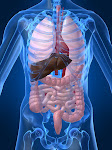


- Left pleural cavity – left lung
- Includes right and left pleural cavity and midportion called mediastinum.
- Right pleural cavity – right lung
- Mediastinum
- The anterior surface of this subject's body is that surface that can be seen (the front,) Posterior surface is that surface that can not be seen (the back.)
- Lateral being farther from the mid line
- medial being closer to the mid line
- Dividing the abdominal surface is into 9 regions:
Left hypochondriac LH
Left lumbar LL
Left iliac LI
Epigastric E
Umbilical U
Hypogastric H
Right hypochondriac RH
Right lumbar RL
Right iliac RI
- These regions are formed by two vertical planes and two horizontal planes
- The two horizontal planes are the transpyloric plane TPP and the transtubercular plane TTP. The tubercles are the tubercles of the iliac crests
- The two vertical lines are the lines drawn from right and left mid clavicular region.
Abdominal Quadrants
— The easiest is to separate the surface into 4 quadrants:
— upper left quadrant ULQ
— lower left quadrant LLQ
— upper right quadrant URQ
— lower right quadrant LRQ
— These quadrants are developed by dropping a vertical line down the middle of the sternum MSP and a horizontal line across and through the umbilicus TUP
ABDUCTION: a movement away from the midline of the body. Abduction also refers to the spreading apart of fingers or toes
ADDUCTION: a movement towards the middle of the body. It also refers to movements of the fingers or toes when they are drawn closer together
DORSIFLEXION: a movement of the foot which brings the toes closer to the shin
PLANTAR FLEXION: a movement of the foot which takes the toes further away from the shin; pointing the toes downwards
EXTENSION: straightening of a joint so that two bones move further apart
FLEXION: bending a joint so that two bones move closer together
CIRCUMDUCTION: a complex movement which combines abduction, adduction, extension, and flexion so that a limb, for example, follows a cone-shaped path. Circumduction incorporates all the movements of ball and socket joints (e.g. hips and shoulder)

It’s arduous to find knowledgeable people on this subject, but you sound like you understand what you’re speaking about! Thanks online casinos
ReplyDelete